Vimar ELVOX 6354 Handleiding
Vimar
Niet gecategoriseerd
ELVOX 6354
Bekijk gratis de handleiding van Vimar ELVOX 6354 (12 pagina’s), behorend tot de categorie Niet gecategoriseerd. Deze gids werd als nuttig beoordeeld door 52 mensen en kreeg gemiddeld 4.0 sterren uit 26.5 reviews. Heb je een vraag over Vimar ELVOX 6354 of wil je andere gebruikers van dit product iets vragen? Stel een vraag
Pagina 1/12

6344, 6354
Videocitofono Giotto Digibus
Giotto Digibus monitor
Portier-vidéo Giotto Digibus
Videohaustelefon Giotto Digibus
Videoportero Giotto Digibus
Videoporteiro Giotto Digibus
Manuale installatore - Installer guide
Manuel installateur - Technisches Handbuch
Instrucciones instalador - Manual do instalador

DESCRIZIONE
Videocitofono per portiere elettronico con microcontrollore per codifica e decodifica a 4 e 8
cifre. Corredato di staffa da fissaggio con morsettiera, di 3 pulsanti (apriporta e 2 funzioni
supplementari). Fornito di regolazione del volume di chiamata per 3 livelli e l’esclusione
della chiamata con indicazione su “ ” rosso. Il “LED” verde viene utilizzato per una LED
segnalazione supplementare quando opportunamente collegato.
Questo videocitofono viene utilizzato in abbinamento all’alimentatore Art. 6948.
220 mm
74 mm204 mm
Caratteristiche tecniche videocitofono
- Videocitofono da esterno parete in ABS
- Piastra di aggancio e tasselli per il fissaggio a parete o scatola a 3 moduli.
- TFT LCD 3,5” per 6344, 6354
- Circuito elettronico su schede intercambiabili.
- Segnale video standard CCIR 625 linee 50 quadri per 6344 (b/n), PAL per 6354 (colori).
- Banda passante video 4 MHz
- Temperatura di funzionamento da 0° a +40° C.
- Suoneria elettronica.
- Ingresso per chiamata fuori porta con suoneria distinta dalla chiamata da targa.
- Uscita per suoneria supplementare
PROGRAMMAZIONE E FUNZIONAMENTO
Per programmare il numero del monitor premere il pulsantino (in se ren do un cac cia vi te di
piccole dimensioni attraverso il foro, Fig. 1 particolare A) presente nella parte bassa del
monitor e suc ces si va men te premere e man te ne re premuto il pulsante . Se l’ope ra-
zio ne è stata ese gui ta cor ret ta men te, l’ap pa rec chio entra in pro gram ma zio ne ac cen den do
il diodo LED (Fig. 1 particolare B) visibile an ch’es so attraverso il foro sotto il monitor. In
questo istante si può rilasciare il pulsante . Se il diodo non si accende ripetere l’ope-
razione. Sollevando il mi cro te le fo no del monitor è pos si bi le comunicare con la targa di scala
affinché venga inviato il codice relativo al monitor da pro gram ma re. Quando il codice pro-
veniente dalla targa arriva al monitor, questi lo memorizza e lo mantiene fino alla prossima
eventuale pro gram ma zio ne, anche in mancanza della tensione di ali men ta zio ne del l’im-
pian to. Il monitor spegnerà il diodo LED a conferma della avvenuta pro gram ma zio ne. Du-
rante le fasi di programmazione il comando apertura serratura non è attivo.
Nel caso di impianti con scale con più di una entrata, per la sola fase di programmazione,
è necessario estrarre il connettore relativo al montante monitor delle targhe, lasciandone
una sola in funzione. L’operazione di programmazione può essere ripetuta più volte con
numeri compresi fra valori 00000001 e 99999999.
PROCEDURA DI PROGRAMMAZIONE CHIAVE “TOUCH”
Per programmare una chiave “touch” nella memoria del monitor bisogna seguire questa
procedura:
1) chiamare il monitor da una targa a tastiera digitale.
2) ricomporre il numero e premere dalla targa il pulsante di chiamata intercomunicante
.
3) selezionare la posizione nella memoria, tramite Freccia Su e Freccia Giù, in cui si vuole
memorizzare la chiave e premere C
4) Appoggiare la chiave “TOUCH” nell’apposita fessura della targa, si sentirà nel microte-
lefono del monitor un segnale acustico
5) da questo momento si hanno circa 5 secondi per memorizzare effettivamente la chiave
premendo il tasto “serratura” del monitor; all’avvenuta programmazione si sentiranno
in sequenza tre bip ed il monitor si spegnerà. Se dovesse trascorrere il tempo di pro-
grammazione senza aver premuto il tasto serratura, il citofono si spegnerà senza aver
programmato la chiave e si dovrà ripetere tutta la procedura dall’inizio.
REGOLAZIONE CHIAMATA / FUNZIONE UTENTE ASSENTE
Il selettore a 4 posizioni (Fig. 1, particolare C) permette di regolare il volume dell’altopar-
lante e se posto nell’ultima posizione a sinistra lo esclude accendendo il led rosso. Se
durante questo periodo si viene chiamati il monitor non suona né si attiva, bensì segnala
la chiamata facendo lampeggiare il led ed inviando una chiamata al centralino. Il numero
dei lampeggi (massimo 4) sta ad indicare il numero di chiamate ricevute. Riposizionando il
selettore si ripristina il funzionamento normale e si perde memoria del numero di chiamate
ricevute in questa modalità.
COLLEGAMENTO SEGNALE VIDEO
Se il segnale video è collegato tramite un cavo coassiale il deviatore (Fig. 2 particolare
A) posto nel retro del monitor dovrà essere posto nella posizione sinistra per la versione
con cavo coassiale, altrimenti nella posizione destra per la versione senzacavo coassiale.
N.B. Il ponticello presente sul retro del monitor permette di effettuare la funzione
VIDEOMOVING nelle targhe predisposte o funzione F2, se tagliato permette invece
di effettuare la funzione autoaccensione (Fig. 2 particolare B), vedere programma-
zione targhe.
MORSETTIERA DI COLLEGAMENTO
1) Linea di chiamata digitale
2) Linea fonica secondaria
3) Linea di fonica
4) Linea negativo
5) Linea +13.5 Vcc
6) Segnalazione monitor inserito (per suonerie supplementari o altri servizi)
7) Linea negativo monitor
8) Linea positivo monitor
9) Linea per chiamata fuoriporta
10) Alimentazione distributore video al piano
11) F2 - collegamento per funzioni ausiliarie da collegare se indicato nello schema
12) F1 - collegamento per funzioni ausiliarie da collegare se indicato nello schema
13) Alimentazione segnalatore LED verde.
Fig. 1
Superficie inferiore del monitor
Retro del monitor
Fig. 2
6354
Videocitofono
Giotto colori Digibus
Vimar SpA Viale Vicenza 14
36063 Marostica VI I taly www.vimar.com
CON PONT ICELLO INSE RITO = FUNZIONE F2
PONTI CELLO T AGLIA TO = FUNZIONE AUTOACCENSIONE
WITH J UMP ER I NSERTED = FUNCTION F2
WITH J UMP ER CUT = SELFACTIV ATI ON FUNCTI ON
18V INT 6,2W
Il manuale istruzioni è scaricabile dal sito www.vimar.com
Regole di installazione
L’installazione deve essere effettuata da personale qualicato con l’osservanza delle
disposizioni regolanti l’installazione del materiale elettrico in vigore nel paese dove i prodotti
sono installati.
Conformità normativa
Direttiva EMC
Norme EN 61000-6-1 e EN 61000-6-3.
Regolamento REACh (UE) n. 1907/2006 – art.33. Il prodotto potrebbe contenere tracce di
piombo.
RAEE - Informazione agli utilizzatori
Il simbolo del cassonetto barrato riportato sull’apparecchiatura o sulla sua confezione
indica che il prodotto alla ne della propria vita utile deve essere raccolto separatamente
dagli altri riuti. L’utente dovrà, pertanto, conferire l’apparecchiatura giunta a ne vita
agli idonei centri comunali di raccolta differenziata dei riuti elettrotecnici ed elettronici.
In alternativa alla gestione autonoma, è possibile consegnare gratuitamente l’apparecchiatura
che si desidera smaltire al distributore, al momento dell’acquisto di una nuova apparecchiatura
di tipo equivalente. Presso i distributori di prodotti elettronici con supercie di vendita di almeno
400 m2 è inoltre possibile consegnare gratuitamente, senza obbligo di acquisto, i prodotti
elettronici da smaltire con dimensioni inferiori a 25 cm. L’adeguata raccolta differenziata
per l’avvio successivo dell’apparecchiatura dismessa al riciclaggio, al trattamento e allo
smaltimento ambientalmente compatibile contribuisce ad evitare possibili effetti negativi
sull’ambiente e sulla salute e favorisce il reimpiego e/o riciclo dei materiali di cui è composta
l’apparecchiatura.
2
6344 - 6354
IT

DESCRIPTION
Monitor for video door entry system with 4 and 8 digit coding and decoding. Provided with
fixing bracket with terminal block, 3 push-buttons (lock release and 2 adidtional functions),
3 level call volume adjustment and exclusion of call signalled by red led. The green LED is
used for an additional signaalling (when properly connected).
This monitor is used in conjuction with power supply type 6948.
220 mm
74 mm204 mm
Monitor technical specifications
- Wall-mounted monitor in ABS
- Backing plate and plugs for wall-mounted fixture or 3-module box.
- TFT LCD 3,5” for 6344 and 6354.
- Electronic circuit on interchangeable cards.
- Standard video signal CCIR 625 lines 50 squares for 6344 (b/w) and PAL for 6354
(color).
- Video pass band 4 MHz
- Operating temperature from 0° to +40° C.
- Electronic ringtone.
- Input for door calls with different ringtone from panel calls.
- Output for additional ringtone.
PROGRAMMING AND OPERATION
To program the monitor number press (by inserting a small screwdriver through the hole
Fig. 1, detail A) the push-button present on the lower side of monitor and then press
and keep pressed the push-button. If the operation has been carried out correctly, the set
enter the programming mode by lighting the diode LED (Fig. 1, detail B) also visible through
the hole under the monitor. Now the push-button can be released. If the diode does
not light up repeat the operation. Lifting the monitor handset it is possible to communicate
with the secondary entrance panel in order to send the code related to the monitor to be
programmed. When the code coming from the entrance panel arrives to the monitor, this
stores it and keeps it in memory until the next programming, even during a mains failure.
The monitor will switch the led off confirming the programming. During the programming
phase the lock release command is not active. In case of installations with stairs with more
than one entry, for the only programming phase , it is necessary to remove the connector
related to the monitor riser of entrance panels, leaving only one in function. The program-
ming operation may be repeated several times by using numbers included between
00000001 and 99999999.
PROCEDURE FOR “TOUCH KEY” PROGRAMMING
To program a “touch key” in the monitor memory follow the underwritten procedure:
1) Call the monitor from a digital keypad entrance panel .
2) Re-dial the number and press the intercommunicating call push-button from the en-
trance panel
3) Select the position in the memory, by using the “FRECCIA SU” (arrow up) and “FREC-
CIA GIU’” (arrow down), where you want to memorize the key and press C.
4) Lean the key “TOUCH” in the proper entrance panel slot; you will hear an acoustic
signal on the monitor handset.
5) From now you will have 5 seconds to memorize the key by pressing the monitor “lock”
push-button; once the programming has been carried out you will hear three beeps
and the monitor will switch off. If the programming time expires before you press the
lock push-button, the interphone will switch off without programming the key and all the
procedure must be repeated from the beginning.
ADJUSTMENT OF CALL/UNATTENDED CALL FUNCTION
The 4 position selector (Fig. 1, detail C) allows the loudspeaker volume to be ajusted and,
if set to the last left position, it excludes the audio by lighting the red LED. If a call is made
during this period, the monitor does not sound and it is not activated, but it signals the call
making the led flash and a call be routed to the switchboard. The number of flashings (max
4) indicates the number of incoming calls. Setting the selector again, the normal operation
is re-establised and the number of incoming calls stored in the memory on this mode is
cancelled.
VIDEO SIGNAL CONNECTION
If the video signal is connected by a coaxial cable, the deviator (Fig. 2, detail A) (placed on
Lower side of monitor
Rear monitor
the monitor rear side) must be set to the left hand position for the coxial cable version, or in
the right hand position for version withoutcoaxial cable.
N.B. The jumper present on the monitor rear side allows the VIDEOMOVING function
to be carried out on preset entrance panels or Function 2; on the contrary with cut
jumper it allows the selfactivation function to be carried out (Fig. 2, detail B), see
entrance panel programming.
TERMINAL BLOCK
1) Digital call line
2) Secondary entrance panel audio line
3) Audio line
4) Negative line
5) + 13,5V DC line
6) Inserted monitor signalling (for additional chimes or other services)
7) Monitor negative line
8) Monitor positive line
9) Line for outside door call.
10) Supply voltage for video floor distributor
11) F2 - connection for auxiliary functions, to be connected if indicated on the diagram.
12) F1 - Connection for auxiliary functions, to be connected if indicated on the diagram.
13) Supply voltage for green LED indicator
Fig. 2
6354
Videocitofono
Giotto colori Digibus
Vimar SpA Viale Vicenza 14
36063 Marostica VI I taly www.vimar.com
CON PONT ICELLO INSE RITO = FUNZIONE F2
PONTI CELLO T AGLIA TO = FUNZIONE AUTOACCENSIONE
WITH J UMP ER I NSERTED = FUNCTION F2
WITH J UMP ER CUT = SELFACTIV ATI ON FUNCTI ON
18V INT 6,2W
Fig. 1
The instruction manual is downloadable from the site www.vimar.com
Installation rules
Installation should be carried out by qualied personnel in compliance with the current
regulations regarding the installation of electrical equipment in the country where the products
are installed.
Conformity
EMC directive
Standards EN 61000-6-1 and EN 61000-6-3.
REACH (EU) Regulation no. 1907/2006 – Art.33. The product may contain traces of lead.
WEEE - Information for users
If the crossed-out bin symbol appears on the equipment or packaging, this means
the product must not be included with other general waste at the end of its working
life. The user must take the worn product to a sorted waste center, or return it to the
retailer when purchasing a new one. Products for disposal can be consigned free of charge
(without any new purchase obligation) to retailers with a sales area of at least 400m
2, if they
measure less than 25cm. An efcient sorted waste collection for the environmentally friendly
disposal of the used device, or its subsequent recycling, helps avoid the potential negative
effects on the environment and people’s health, and encourages the re-use and/or recycling
of the construction materials.
3
EN
6344 - 6354
Product specificaties
| Merk: | Vimar |
| Categorie: | Niet gecategoriseerd |
| Model: | ELVOX 6354 |
Heb je hulp nodig?
Als je hulp nodig hebt met Vimar ELVOX 6354 stel dan hieronder een vraag en andere gebruikers zullen je antwoorden
Handleiding Niet gecategoriseerd Vimar
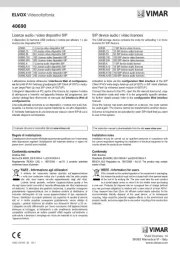
2 September 2025
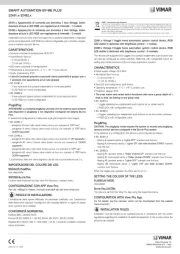
26 Augustus 2025
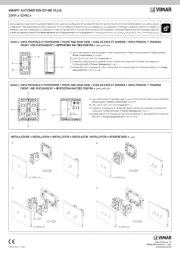
26 Augustus 2025
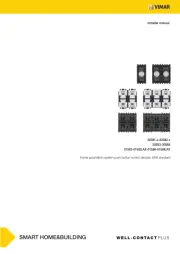
26 Augustus 2025
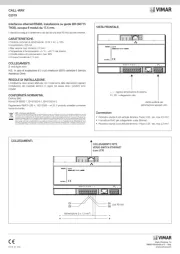
14 Augustus 2025
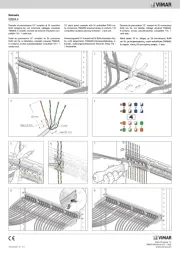
5 Juli 2025
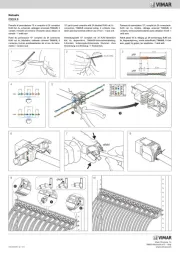
5 Juli 2025
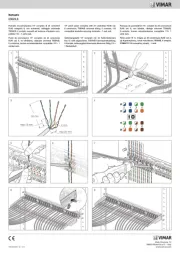
5 Juli 2025

5 Juli 2025
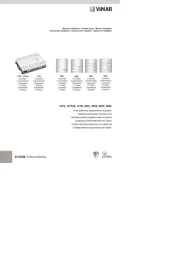
24 Mei 2025
Handleiding Niet gecategoriseerd
- O&O Software
- Osprey
- TAMA
- Vent-A-Hood
- Goobay
- Plantronics
- Nevadent
- Bentley
- Ember
- Safescan
- IsoAcoustics
- Harper
- Flame
- Enhance
- Cherry
Nieuwste handleidingen voor Niet gecategoriseerd

14 September 2025

14 September 2025

13 September 2025

13 September 2025

13 September 2025

13 September 2025

13 September 2025

13 September 2025

13 September 2025

13 September 2025